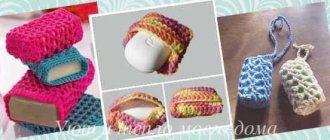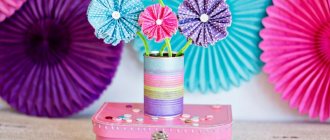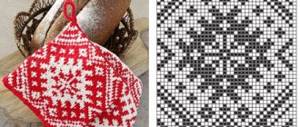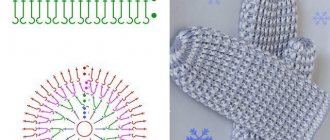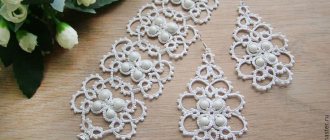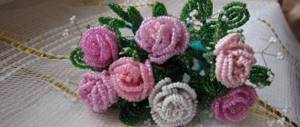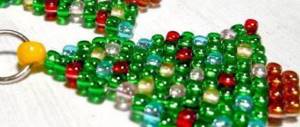Needlework
06/07/2018 Anastasia Prozheva
Despite the fact that among young people the very concept of shawls and scarves often evokes associations of “grandmother’s” things, these wardrobe accessories not only do not lose their vitality, but, on the contrary, are at the peak of fashion. Voluminous stoles, mufflers, and scarves can often be found in the collections of successful designers. Draped in intricate pleats, these pieces look stylish and sophisticated, and certainly don't evoke the image of an old lady. This article offers a detailed look at how to crochet a white shawl.
Common types of shawls
A typical shawl is a cape over the shoulders. Depending on the season and purpose, the appearance of the accessory may change. The following types of products are popular:
- Summer cape. A lightweight item of any typical shape. Helps keep you slightly warm during the warm season.
- Cape. A small round cape. Used for insulation in combination with formal outfits.
- Bactus. A triangular shaped thing. Designed to be used instead of a classic scarf.
- Handkerchief. Square shape option. When used, it is usually folded in half into a triangle.
- Stole. Scarf with increased dimensions. The item is made longer and wider.
Sometimes a shawl is even called a poncho. The product envelops the entire body of the body, covering not only the shoulders, but also the back, chest, stomach, and arms.
Recommendations for selection
Based on the diagrams and descriptions, even a novice knitter can easily knit a beautiful shawl. Despite the fact that there are a great variety of knitting methods, even the most complex pattern is usually knitted with great inspiration.
- For short women with round shapes, a light lace cape or triangular shawl with an elegant pattern is best suited, as voluminous and bright colors can make the look heavier;
- For tall bobby-makers, stoles and scarves with tassels with larger vertical striped patterns are suitable; such patterns visually slim the figure;
- A thin girl would be more suited to a bright scarf with large flowers; its dense drapery will perfectly hide fragile shoulders and a narrow neck;
- Proper fit of the shawl to the figure can hide existing flaws, as well as highlight advantages. For example, if the shoulders are too wide, the corners of the shawl should hang slightly lower, and not end at the shoulders themselves. And small breasts under a fluffy knitted shawl look more voluminous;
- With a short or full neck, the ends of the cape should hang in longitudinal stripes, or it is advisable to pin both ends with a brooch;
- If you have a proportionate figure, that is, the shoulders, waist and hips do not stand out particularly, the shawl can be worn on one shoulder, lowering the other side of the cape.
Related article: DIY ribbon bracelets: how to make, diagrams with photos and videos
Preparing for work
Before starting the fascinating process of knitting, be sure to determine the model of the product. The next stage will be the selection of tools and materials. Each preparation step has some nuances.
Selecting a product type
After looking at the photo of knitting a shawl, it becomes clear that different products will be made. Simple bacti are popular among beginners.
Experienced craftswomen knit openwork shawls. Attention is paid to the size of the proposed product, design, and complexity of execution.
Yarn selection
It is better for beginners to hone their experience on yarn of medium thickness. In this case, it is better to take options of light shades for work. Threads with a mixed composition fit well into the product: natural fibers with synthetics.
We recommend reading:
Knitting bactus with knitting needles - detailed description with photos and diagrams. Step-by-step instructions and recommendations from craftswomen. TOP 30 best modelsKnitting socks with knitting needles - step-by-step master class with instructions. A selection of the best knitted socks models
Garter Stitch Knitting - 140 photos and videos of basic garter stitch patterns and projects
Experienced craftswomen can take on “cobwebs” made from the finest threads. It is difficult to work with silk, weightless or fluffy fluff.
Choosing yarn for a shawl
Before you start creating, you should choose the best threads for your future shawl. These should be thin threads which may include:
- wool (alpaca, merino);
- mohair (usually kid mohair);
- angora.
The choice of thread depends on what kind of shawl you need. If it is airy, weightless and openwork, then it is better to choose kid mohair. This is a wool thread made from the delicate fluff of young sheep on a silk or synthetic base. It is thin and weightless in the product. This type of yarn is offered by various manufacturers: Turkish, Italian, German and Russian.
Silk-based thread will cost more, but it is soft as feathers and silky to the touch. In terms of warmth, a thread based on synthetic fiber is not inferior, in terms of tactile properties it is quite soft and not prickly, but people with sensitive skin can see the difference between them in favor of silk. Angora will make the shawl fluffy, soft and warm, but it will no longer be so airy and light.
Shawls made of fine wool are a fairly common option. They can be made openwork and monotonous, smooth. Knitting patterns for just such shawls, new for 2020, are given below in the article. In any case, for a scarf, shawl, bactus, stole, you should choose a soft thread so that the product drapes and falls beautifully.
https://youtu.be/https://youtube.com/watch?v=RiAgyPXNk6g
_
Preparing tools
The choice of tool depends on the yarn. It is important to take into account the manufacturer's recommendations. The thinner the thread, the smaller the number of hooks to work with.
It is easier for beginners to manipulate a tool of medium thickness. It is better to refuse options marked less than 1 at the beginning of your creative journey.
Basic yarn requirements for this model:
- Let's determine the required composition , for this you need to understand what the seasonality of the shawl will be - for the summer we choose cotton, linen, silk, or mixes of them; For winter, wool (including Kauni, Dundaga), merino, kid mohair on silk, cashmere, or mixes of them are suitable. We knit demi-season shawls from average threads (which are not suitable for either winter or summer - for example, thick cotton - hot for summer, cold for winter, but just right for spring-autumn) or mix threads.
- Next we answer the question “what footage is needed»—what length/thickness should the yarn be. In most descriptions of shawls, designers indicate the recommended footage. To begin with, what is footage? This is the number of meters of thread per unit of weight (skeins can be 25g (kid mohair on silk), 50g, most often 100g). The meterage (as well as the composition) is always indicated on the yarn labels. In the case of using bobbin yarn, you need to look at the markings, it is different for the bobbins, recalculation is necessary. Well, let's return to the question - what should the footage be? Relevant! Corresponding to the pattern and knitting needles (hook). Kid mohair on silk is always knitted with thick needles - the thread is fluffy, and you need space in the loops and fabric for it to fluff up. If the pattern is openwork, then the thread should be thin - then the openwork will show all its grace. If the pattern is dense and the shawl is winter, then you can take a thicker thread - for example, Kauni 8/2 (this is 400m 100g). For thin webs that are traditionally knitted in Estonia, Haapsalu yarn (Lithuania) 100g-1400m is used. 100% wool.
- Consumption. How many threads should I take??? This, again, is often indicated in the descriptions, but you always need to make adjustments to the density of your knitting (whether you knit tightly or loosely) and the tool number. It’s always better to take extra thread than to later search (sometimes unsuccessfully, because the batch number may differ and the shade of the purchased yarn may not match yours) for the missing skein.
Running a sample
The selected yarn, hook, and pattern must be tested. It is recommended to make a sample measuring 10 cm in width and height.
The test copy must be washed and dried. After completing these steps, we begin to calculate the loops for the main product.
We recommend reading:
- How to knit a turban with knitting needles - 115 photos and videos of ideas, patterns and features of knitting a turban
Knitting bags - 155 photos and videos on how to quickly knit a stylish bag with descriptions and diagrams
Knitting a jacket: 125 photos and video description of knitting with patterns for beginners and masters
Knitting patterns for beginners
There are different patterns for knitting a shawl. Beginners are advised to choose those options that contain monotonously repeating motifs.
In this case, it is not necessary to knit in separate blocks, subsequently assembling the product piece by piece. There are similar schemes for continuous webs.
Yarn for Shawls
An accessory such as a shawl is a rather voluminous item and, accordingly, it will take a lot of yarn, so it may be heavy and not bring the expected wearing comfort. It is desirable that the shawl or scarf be practically weightless, but at the same time warm enough. In addition to warmth, the shawl should also be beautiful, so you need to choose yarn for such a product very carefully.
The craftswoman can decide which yarn to choose for knitting a shawl on her own, having a little understanding of its composition. The most acceptable option would be a thin, well-twisted thread. It will make the product more airy, lighter and warmer.
The first place among the huge selection of yarn is, of course, wool. Since wool is similar in structure to human hair, it is therefore most pleasant when in contact with the skin. Modern methods of processing wool produce an excellent soft thread and the fabric is not scratchy. Wool fabric retains heat well and slowly absorbs moisture from the environment. The only drawback of wool is its matting and formation of pellets. But modern industry has been able to overcome this drawback by combining woolen thread with artificial thread, such as acrylic. Among pure wool yarns, the most valuable ones can be distinguished. Alpaca is the loosely curly wool of llamas native to South America. Angora yarn - obtained from the wool of the Angora rabbit, its fibers are very thin and light. Products made from Angora yarn are very warm and hygroscopic, but require very careful care. To knit a shawl, it is best to use yarn with a small angora content, since fine fluff will constantly fly off the finished product. Cashmere yarn is a valuable material, so shawls and stoles made from it are the most expensive. Cashmere yarn is made from rare raw materials, which are obtained by combing the wool of cashmere goats only at certain times of the year. Products made from pure cashmere are distinguished by their special durability and quality. Mohair yarn - things made from it are unusually light and fluffy, beautiful and warm. To knit a shawl, you should choose a thread with a 30% mohair content. With careful care, the product will retain its delightful appearance for a long time, and to create a shawl from such yarn it is not at all necessary to choose an intricate knitting pattern.
Artificial fibers include acrylic, which has a number of positive properties and qualities.
. Acrylic yarn is quite durable and at the same time soft, practically does not fade in the sun and has the widest color spectrum. Acrylic thread gives wool fiber additional softness and lightness. The product, knitted from acrylic yarn with mohair, holds its shape perfectly, while maintaining its unique fluffiness and airiness.
Cotton yarn allows you to create things that are pleasant to wear and easy to care for. The main properties of cotton can be considered its hygiene and resistance to frequent washing; it is perfectly breathable and easily absorbs moisture. The disadvantage of cotton is that things take a long time to dry and can shrink a lot if washed incorrectly. Since cotton yarn has little elasticity, it is best used in a mixture with wool or acrylic. It is worth noting that for knitting thin summer shawls and stoles, pure cotton is often used or mixed with viscose, which gives things a chic shine.
Viscose fiber is an excellent material, soft and pleasant to the touch, perfectly absorbs moisture. Pure viscose is quite heavy and products stretch under their own weight, which should be taken into account when making them. A shawl made from viscose yarn will look rich and elegant; it is simply irreplaceable in the heat, as this material gives a feeling of coolness.
Goat down is an ideal material for knitting warm scarves and shawls that will keep you warm in the most severe frosts.
For true fans of original things, we can recommend fancy yarn, which is very diverse in its composition. Such variety will allow even beginning craftswomen to knit an amazing thing without using intricate patterns. Fancy yarns include ribbon yarn, boucle yarn, with lurex thread, beads, etc.
What yarn to choose for knitting a shawl? First of all, you need to decide what it will serve you for. If you need a shawl for warmth, then you should choose wool yarn, yarn with mohair or angora, a mixture of cashmere with cotton or acrylic.
Mohair yarn is suitable for knitting elegant shawls, which should not be worn under outerwear, as during wear the product will quickly become matted and lose its attractiveness.
Over time, every knitter accumulates a large number of threads left over from knitting various things. You can always put these leftovers to work and knit a chic shawl that will come in handy on cool evenings in the country or outside the city. The remains can be sorted by colors and shades, arranged according to texture and the most advantageous product option can be selected for them.
Yarn from unraveled old or out-of-fashion items is also suitable for knitting shawls and stoles. Things should be ripped apart at the seams and unraveled, winding the thread into pastes. Ready-made pastas should be washed according to their composition. If the composition is unknown, then the yarn should be washed in warm water with the addition of a mild detergent. In order to refresh the color of loose yarn, it should be rinsed in cool water with the addition of vinegar, at the rate of 1 tbsp. l. vinegar per 1 liter of water. To make the threads soft and shiny, you should add a special fabric softener to the rinse, which also has a pleasant aroma. The dried pasta is then rewound into balls, from which it will be much more convenient to knit.
Pattern "Pineapples"
The most common, simple, and quite attractive pattern is considered to be a pattern of cones or pineapples formed by chains of air loops.
For beginners, it is better to start from a corner. The working surface is gradually expanded. The best thing: choose a ready-made scheme.
The bumps can be located one after another, on a grid or other background. If you have experience, you can dream up the pattern yourself.
Shawl with fillet pattern
The good thing about the fillet knitting method is that it does not require high skill. You will only have to be able to perform air loops and single crochets.
They act according to the scheme of the selected pattern. You can use any picture developed for this technique as a basis.
The pattern is knitted against a background of fillet mesh. Work on the shawl begins from the bottom corner of the product. For beginners, it is better to use ready-made diagrams of such things.
Shell pattern
Shells are one of the most common crochet patterns. The method involves knitting a certain number of stitches with two or more crochets into one loop of the base.
Related article: Beautiful crochet lampshade
There are many options for knitting “shells”. We suggest performing another version of the shell knitting pattern:
Let's knit a test sample.
Tie a chain of 10 cm chain stitches. Make 1 yarn over the hook and insert it into the 7th loop – 1 double crochet – 1 yarn over the same loop – insert the hook. Second double crochet – yarn over hook – 1 double crochet (first shell is ready). Next, 1 chain loop - 3 base loops - in 4 loops 3 double crochets (second shell). Continue knitting the row until the end in the same way. Afterwards there are 3 lifting air loops. Knit the second and subsequent rows according to the pattern, alternating fans of 3 double crochets and chain stitches.
Shawl with Spider pattern
A product with a pattern of “spiders” is considered a real classic. The number and arrangement of elements can easily be changed at will during the work process.
The pattern can be combined with plain knitting or other patterns. It is better for beginners to act strictly according to the ready-made scheme. Knitting begins from the middle of the wide edge.
Modern models
Let's look at shawl knitting patterns, new for 2020.
Stylish shawl
This is a shawl with turquoise holes made from cotton thread. For it you will need cotton yarn (you can use LANGYARNS AMIRA or any other) and knitting needles No. 6.
Knitting starts from a corner and increases on one side in every second row until the required width is reached, then decreases in the same order.
The holes are made like this: where the hole is supposed to be, skip 4 loops and cast on 4 turns of thread on a working knitting needle to form the loops of the next row and continue knitting through the 4 skipped loops, we knit the next row as usual, knitting the cast-on loops in the place of the hole. This diagram is shown below.
Shawl “Firebird Feather”
This eye-catching pattern requires two colors of yarn. The main color and the one used to knit feathers. Size 4 needles and circular needles.
Let's get started:
- We knit the shawl fabric in garter stitch (only knit stitches in all rows).
- You need to cast on 130 loops with the main thread and knit in short rows without knitting 5 loops to the edge. So we knit the required number of rows.
- Then we introduce thread for knitting a feather. And we knit according to the pattern. Also in short rows.
- Then again use a thread of the main color and then add a feather.
- You can make as many of these repeats with feathers as you want, alternating with the main color.
- To knit the feathers in this shawl, you can use melange or sectional yarn.
Shawls and bactuses knitted from the center
An amazing and stylish bactus, or shawl, is offered by Caroline Wayne. It is simple to perform and very effective. This shawl can be knitted from any thread. Made from fine mohair, fine or medium wool. From plain or sectionally dyed threads. The latter will give an amazing color transition effect and make the accessory unique.
Designer shawl by Caroline Weins
So, how can you knit this shawl? To work you will need:
- yarn (1-2 skeins of 100 g each, depending on the desired size of the shawl);
- knitting needles matching the thread number. You can take more, since the knitting should not be tight.
Let's get started:
- Work begins from the middle of the base of the shawl. We put 2 loops on the knitting needles and begin to knit the bar, knitting 6 rows only with facial loops. This is the start of a strip at the base of the shawl that will continue across the entire width of the shawl.
- Returning back, you need to lift 7 loops along the connected bar. There should be 9 loops on the knitting needle along with those that were originally cast on.
- Next, distribute the existing loops according to the shawl pattern. The main thing here is to understand the principle and knitting will not be difficult. The loops are distributed like this: 2 loops on one and the other edge - this is a bar that will always (both in the front and back rows) be knitted with front loops. 1 central loop (you can mark it with a marker, it does not change and on the sides of it there will be increases in the front rows to expand the shawl fabric). 2 knit stitches on each side of the central loop. This is how we distributed the loops.
- Next comes the main knitting, which is as follows: 2 side loops on each side will be knitted in the purl and knit rows.
- We will make increases in each row (in the back and front) after knitting the side loops from the broach and in the front rows on the sides of the central loop in each front row.
- We knit the main fabric in stockinette stitch, that is, in the front rows - with facial loops, in the purl rows - with purl stitches.
- We knit the mesh pattern like this: front row – 2 knit stitches together, 1 yarn over; purl row - purl all loops and yarn overs.
Important! Before and after the mesh pattern, the purl row must be knitted with facial loops to form the edging of the pattern.
The mesh pattern can be distributed as desired, in 1 row at equal intervals of the front surface, in increasing order - 1 row, then 2 rows, then 3 and so on, or knit several rows of the pattern at the bottom of the shawl. As your imagination dictates.
The ends of the shawl can be decorated with tassels or beads.
Patterns for experienced knitters
Possession of skill allows you to “swing” at a more complex model. There are different original DIY shawl ideas. The choice is limited only by the personal preferences of the experienced craftswoman.
Shawl “Golden Autumn”
Products made using the Irish lace technique look gorgeous. The method involves the development of motives of different formats. You can knit patterns of autumn leaves, flowers, fruits in autumn shades.
All parts are connected using mesh strapping. You can take winter or spring themes as a basis.
Which color should I choose?
Well, of course, this is a matter of taste, but there are rules too. I wrote about the sectional a little higher, I won’t repeat myself, I’ll also say about the correspondence of the color of the yarn to the pattern - for example, if you decide to knit the “Cornflowers” cape, then it is recommended to take the colors that are typical for cornflowers - cornflower blue, white, pink. Personally, I don't see this cape in yellow or green. But the “Spring Leaves” stole is better knitted from green yarn, rather than blue or pink. These rules, of course, are very conditional, but they still contribute to a better perception of your product.
Cape "Peacock"
The luxurious pattern imitating peacock feathers looks original. The option is not considered difficult to perform, but requires care.
Before starting work, carefully study the diagram. You can additionally use lurex, beads, and colored yarn for decoration.
Shutdown
It’s not enough to simply complete the basic part of the shawl according to the pattern. The product must be tied along the edge. You can use simple posts or a patterned border. Blocking makes the item look complete.
Edge binding resists edge stretching. The finished item must be washed, dried, and, if necessary, steamed.
A knitted shawl is a great addition to any wardrobe. The product is used in combination with classic and modern clothing sets.
The greatest value belongs to the options created by hand. If the opportunity to make a product yourself exists, then you should not miss it.
Knitting a simple shawl for beginners
The first master class shows how to knit a shawl for beginners. This delicate and beautiful shawl, as in the photo, is quite easy to knit even for beginners. Below we will give you a description of the work step by step. The patterns are extremely easy to knit, so they are recommended for those who are just learning needlework. To work you will need three hundred and fifty grams of yarn, knitting needles number five, and hook number five. We knit the “knit stitch” and “Rhombus” patterns as required by the corresponding pattern. The first pattern of the shawl is made exclusively with knit and purl stitches, in rows (P), respectively. The “Rhombus” pattern is made according to the pattern, the photo of which you see below.
In this pattern there are knit Ps, and the purls are knitted with purl stitches (IP). Let's start the needlework by casting on three stitches and knitting the first purl row. The first line in the work will not be taken into account, and this must be remembered. The second R will be a knit stitch, and it is knitted with an edge stitch (P), then followed by a knit stitch, a crossed knit stitch, and the last edge stitch. Next comes the purl line, which is knitted IP. We will perform additions of P until there are eighty-five P on the knitting needles. At the point where there are eight units on the knitting needles, we will begin to make the “Rhombus” pattern according to the pattern that you see in the photo. Having completed the length of eighty centimeters, we will begin to reduce the number of units. To do this, on the left side we knit two knit stitches together. We will tie the edge using a hook with two P single crochets.
Read
Let's learn everything about knitting a hood
Photos of crocheted shawls
Did you like the article?
0
